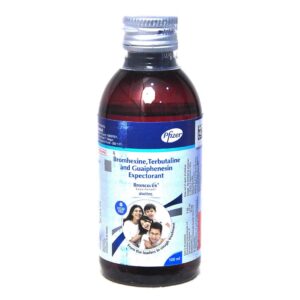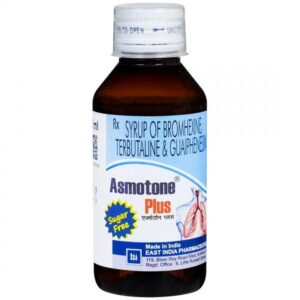BROMHEXINE + TERBUTALINE + GUAIPHENESIN
Bromhexine: Bromhexine is a drug that is primarily used as an expectorant, and it is commonly prescribed to treat respiratory conditions characterized by excessive mucus or phlegm production, such as bronchitis, chronic obstructive pulmonary disease (COPD), and asthma.
The mechanism of action of bromhexine involves increasing the production and secretion of thinner mucus in the respiratory tract. It accomplishes this by stimulating the activity of specialized cells called goblet cells, which are responsible for producing mucus. By promoting the secretion of thinner mucus, bromhexine helps to facilitate its removal and clearance from the airways, making it easier for individuals to cough up phlegm.
The typical dose of bromhexine for adults is 8 mg to 16 mg, three times daily. It is recommended to be taken after meals with a glass of water. However, the exact dosage may vary depending on the specific condition being treated, so it is important to follow the instructions provided by the healthcare professional.
Like any medication, bromhexine can cause side effects in some individuals. The most common side effects include nausea, gastrointestinal disturbances (such as stomach pain or diarrhea), headache, and skin rashes. Other possible side effects that may occur, although less common, include dizziness, fatigue, dry mouth, and allergic reactions.
It is worth noting that bromhexine should be used with caution in individuals with peptic ulcers or a history of gastric bleeding, as it may exacerbate these conditions. Additionally, it is important to inform the healthcare provider of any other medications being taken, as bromhexine may interact with certain drugs, such as antitussives (cough suppressants) or medications that affect liver enzymes. Pregnant or breastfeeding women should consult with a healthcare professional before using bromhexine.
As with any medication, it is crucial to use bromhexine only as prescribed and under the guidance of a healthcare professional.
Terbutaline: Terbutaline is a medication used to treat and prevent bronchospasm in conditions such as asthma, chronic obstructive pulmonary disease (COPD), and bronchitis. It belongs to a class of drugs known as beta-adrenergic agonists or bronchodilators.
The main mechanism of action of Terbutaline is by stimulating beta-2 adrenergic receptors in the smooth muscle of the airways. This stimulation causes relaxation of the bronchial muscles, which opens up the airways, making breathing easier. It also inhibits the release of inflammatory substances that can contribute to bronchospasm.
Terbutaline can be taken as an oral tablet, sublingual tablet, or as an inhaler. The dosage varies depending on the condition being treated and the age of the patient. For asthma and COPD, the typical adult oral dose is 2.5 to 5 mg every 6 to 8 hours, whereas the inhaler is used as needed for acute symptoms. It is important to follow the dosage instructions provided by the healthcare provider.
Like any medication, Terbutaline can have side effects. Common side effects include headache, tremor, nervousness, dizziness, palpitations, and increased heart rate. These effects are usually mild and go away on their own. However, if these side effects persist or worsen, it is important to consult a healthcare professional.
In rare cases, Terbutaline may cause more serious side effects such as chest pain, irregular heartbeat, severe allergic reactions, and high blood sugar levels. It is important to seek immediate medical attention if any of these symptoms occur.
Terbutaline should not be used in patients with certain conditions such as uncontrolled high blood pressure, heart disease, or an overactive thyroid gland, as it may worsen these conditions. It is also not recommended during pregnancy or breastfeeding unless specifically prescribed by a healthcare provider.
Overall, Terbutaline is an effective bronchodilator used to relieve and prevent bronchospasm in conditions such as asthma and COPD. It should be used as directed by a healthcare provider and any concerns or side effects should be discussed with them.
Guaiphenesin: Guaifenesin is an expectorant medication commonly used to relieve chest congestion caused by respiratory conditions such as the common cold, bronchitis, and sinusitis. It is available over-the-counter and in prescription forms.
The mechanism of action of guaifenesin is not fully understood, but it is believed to work by increasing the volume and reducing the viscosity of respiratory tract secretions, making it easier to expel mucus and phlegm from the lungs. It is thought to act on the nervous system to stimulate the flow of respiratory tract fluids.
The recommended dose of guaifenesin for adults and children over 12 years old is typically 200-400 mg every four hours, with a maximum daily dose of 2,400 mg. However, it is important to read the label instructions and follow the recommendations of a healthcare provider or pharmacist as dosing may vary depending on the specific product and individual needs.
Common side effects of guaifenesin include nausea, vomiting, stomach upset, dizziness, headache, and rash. These side effects are generally mild and temporary. Allergic reactions to guaifenesin are rare but can occur, leading to symptoms such as itching, swelling, and difficulty breathing. It is important to seek medical attention if any severe or persistent side effects occur.
Guaifenesin may interact with certain medications such as anticoagulants (blood thinners) and sedatives, so it is important to inform healthcare providers of all medications being taken to avoid potential drug interactions.
It is worth noting that while guaifenesin can provide relief from symptoms associated with respiratory congestion, it does not treat the underlying cause of the condition itself. Therefore, if symptoms persist or worsen, it is recommended to consult a healthcare professional for further evaluation and appropriate treatment.


